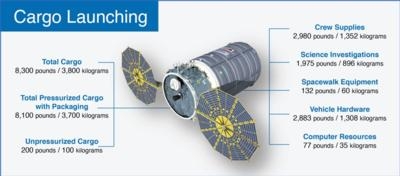Thu, Feb 24, 2022
Launch Delivers Projects, Supplies, and Experiments to Mission 66
Taking on the perceived dominance of SpaceX in taking on resupply missions for the International Space Station, Northrop Grumman successfully delivered an 8,300-pound supply run aboard a Cygnus spacecraft.

The delivery marks the 17th contracted mission under the company's Commercial Resupply Services contract. The Cygnus will remain at the station until May, when it will deploy CubeSats and drop thousands of pounds of garbage during re-entry for easy disposal.
Aboard the resupply mission, a number of scientific projects, equipment, and experiments were delivered alongside the regular day to day living and operational cargo needed to survive in orbit. The experiments will join more than 250 similar scientific efforts already in progress on the station during NASA's Expedition 66 mission.
Some of the banner projects include cell cultures to assess skin deterioration, aging, and the effects of microgravity on dermal cells over their lifetime. Colgate hopes that its Skin Aging program will "speed development of products aimed at protecting skin from the aging process on Earth." Another medical specialist, MicroQuin, has a similar project to analyze the effects of a therapy on breast and prostate cancer cells. The company has seen indications that the desired cells tend to grow into a more natural, effective 3-dimensional model while in microgravity, making it easier to analyze their workings and place in the greater human ecosystem at a microscopic level.

Other equipment projects include a space demonstrator for solid-state lithium ion batteries in zero gravity and an advanced hydrogen sensor system. Those parts will test for possible improvements to vital atmosphere sensors that currently require higher, constant replacement throughout the mission to ensure safety. Finally, a prototype, multi-fuel combustion tester to assess varying concentrations of oxygen and fuel pressures to improve the safety of future EVA suits, materials, and fire suppressors in space.
More News
From 2023 (YouTube Version): Legacy of a Titan Robert (Bob) Anderson Hoover was a fighter pilot, test pilot, flight instructor, and air show superstar. More so, Bob Hoover was an i>[...]
Get The Latest in Aviation News NOW on Instagram Are you on Instagram yet? It's been around for a few years, quietly picking up traction mostly thanks to everybody's new obsession >[...]
Aero Linx: B-52H Stratofortress The B-52H Stratofortress is a long-range, heavy bomber that can perform a variety of missions. The bomber is capable of flying at high subsonic spee>[...]
Altimeter Setting The barometric pressure reading used to adjust a pressure altimeter for variations in existing atmospheric pressure or to the standard altimeter setting (29.92).>[...]
"Knowing that we play an active part in bettering people's lives is extremely rewarding. My team and I are very thankful for the opportunity to be here and to help in any way we ca>[...]
 Classic Aero-TV: Remembering Bob Hoover
Classic Aero-TV: Remembering Bob Hoover ANN FAQ: Follow Us On Instagram!
ANN FAQ: Follow Us On Instagram! ANN's Daily Aero-Linx (05.15.24)
ANN's Daily Aero-Linx (05.15.24) ANN's Daily Aero-Term (05.15.24):Altimeter Setting
ANN's Daily Aero-Term (05.15.24):Altimeter Setting Aero-News: Quote of the Day (05.16.24)
Aero-News: Quote of the Day (05.16.24)




